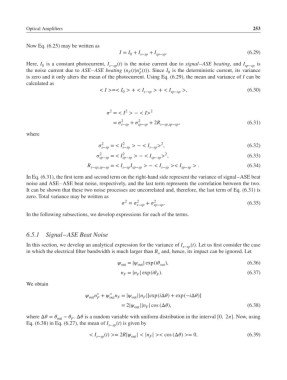Page 272 - Fiber Optic Communications Fund
P. 272
Optical Amplifiers 253
Now Eq. (6.25) may be written as
I = I + I s−sp + I sp−sp . (6.29)
0
Here, I is a constant photocurrent, I s−sp (t) is the noise current due to signal–ASE beating, and I sp−sp is
0
∗
the noise current due to ASE–ASE beating (n (t)n (t)). Since I is the deterministic current, its variance
F
0
F
is zero and it only alters the mean of the photocurrent. Using Eq. (6.29), the mean and variance of I can be
calculated as
< I >=< I > + < I s−sp > + < I sp−sp >, (6.30)
0
2
2
= < I > − < I> 2
2
= s−sp + 2 sp−sp + 2R s−sp,sp−sp , (6.31)
where
2
2
s−sp = < I 2 s−sp > − < I s−sp > , (6.32)
2
2 sp−sp = < I 2 sp−sp > − < I sp−sp > , (6.33)
R = < I I > − < I >< I >. (6.34)
s−sp,sp−sp s−sp sp−sp s−sp sp−sp
In Eq. (6.31), the first term and second term on the right-hand side represent the variance of signal–ASE beat
noise and ASE–ASE beat noise, respectively, and the last term represents the correlation between the two.
It can be shown that these two noise processes are uncorrelated and, therefore, the last term of Eq. (6.31) is
zero. Total variance may be written as
2 2 2
= + . (6.35)
s−sp sp−sp
In the following subsections, we develop expressions for each of the terms.
6.5.1 Signal–ASE Beat Noise
In this section, we develop an analytical expression for the variance of I (t). Let us first consider the case
s−sp
in which the electrical filter bandwidth is much larger than B and, hence, its impact can be ignored. Let
o
= | | exp(i ), (6.36)
out out out
n = |n | exp(i ). (6.37)
F F F
We obtain
∗
∗
n + n = | ||n |[exp(iΔ)+ exp(−iΔ)]
out F out F out F
= 2| ||n | cos (Δ), (6.38)
F
out
where Δ = out − . Δ is a random variable with uniform distribution in the interval [0, 2].Now,using
F
Eq. (6.38) in Eq. (6.27), the mean of I s−sp (t) is given by
< I s−sp (t) >= 2R| | < |n | >< cos (Δ) >= 0, (6.39)
out
F

